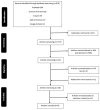Effect of Chronic Ankle Instability on the Biomechanical Organization of Gait Initiation: A Systematic Review
- PMID: 38002555
- PMCID: PMC10669647
- DOI: 10.3390/brainsci13111596
Effect of Chronic Ankle Instability on the Biomechanical Organization of Gait Initiation: A Systematic Review
Abstract
This systematic review was conducted to provide an overview of the effects of chronic ankle instability (CAI) on the biomechanical organization of gait initiation. Gait initiation is a classical model used in the literature to investigate postural control in healthy and pathological individuals. PubMed, ScienceDirect, Scopus, Web of Science, and Google Scholar were searched for relevant articles. Eligible studies were screened and data extracted by two independent reviewers. An evaluation of the quality of the studies was performed using the Downs and Black checklist. A total of 878 articles were found in the initial search, but only six studies met the inclusion criteria. The findings from the literature suggest that CAI affects the characteristics of gait initiation. Specifically, individuals with CAI exhibit notable differences in reaction time, the spatiotemporal parameters of anticipatory postural adjustments (APAs) and step execution, ankle-foot kinematics, and muscle activation compared to healthy controls. In particular, the observed differences in APA patterns associated with gait initiation suggest the presence of supraspinal motor control alterations in individuals with CAI. These findings may provide valuable information for the rehabilitation of these patients. However, the limited evidence available calls for caution in interpreting the results and underscores the need for further research.
Keywords: ankle injury; anticipatory postural adjustments; center of pressure; gait; locomotion; muscle activity.
Conflict of interest statement
The authors declare no conflict of interest.
Figures
Similar articles
-
Center of pressure excursion and muscle activation during gait initiation in individuals with and without chronic ankle instability.J Biomech. 2020 Jul 17;108:109904. doi: 10.1016/j.jbiomech.2020.109904. Epub 2020 Jun 22. J Biomech. 2020. PMID: 32636013
-
Effects of biofeedback on biomechanical factors associated with chronic ankle instability: a systematic review with meta-analysis.BMC Sports Sci Med Rehabil. 2023 Dec 13;15(1):168. doi: 10.1186/s13102-023-00780-7. BMC Sports Sci Med Rehabil. 2023. PMID: 38093253 Free PMC article.
-
Initial center of pressure position prior to anticipatory postural adjustments during gait initiation in people with Parkinson's disease with freezing of gait.Parkinsonism Relat Disord. 2021 Mar;84:8-14. doi: 10.1016/j.parkreldis.2021.01.012. Epub 2021 Jan 22. Parkinsonism Relat Disord. 2021. PMID: 33517030
-
Kinetic changes of gait initiation in individuals with chronic ankle instability: A systematic review.Health Sci Rep. 2024 Oct 30;7(11):e70143. doi: 10.1002/hsr2.70143. eCollection 2024 Nov. Health Sci Rep. 2024. PMID: 39479288 Free PMC article. Review.
-
Individuals with chronic ankle instability exhibit dynamic postural stability deficits and altered unilateral landing biomechanics: A systematic review.Phys Ther Sport. 2019 May;37:210-219. doi: 10.1016/j.ptsp.2018.06.003. Epub 2018 Jun 13. Phys Ther Sport. 2019. PMID: 29914742
References
-
- Suttmiller A.M.B., Cavallario J.M., Baez S.E., Martinez J.C., McCann R.S. Perceived Instability, Pain, and Psychological Factors for Prediction of Function and Disability in Individuals with Chronic Ankle Instability. J. Athl. Train. 2022;57:1048–1054. doi: 10.4085/1062-6050-0605.21. - DOI - PMC - PubMed
Publication types
LinkOut - more resources
Full Text Sources
Miscellaneous


